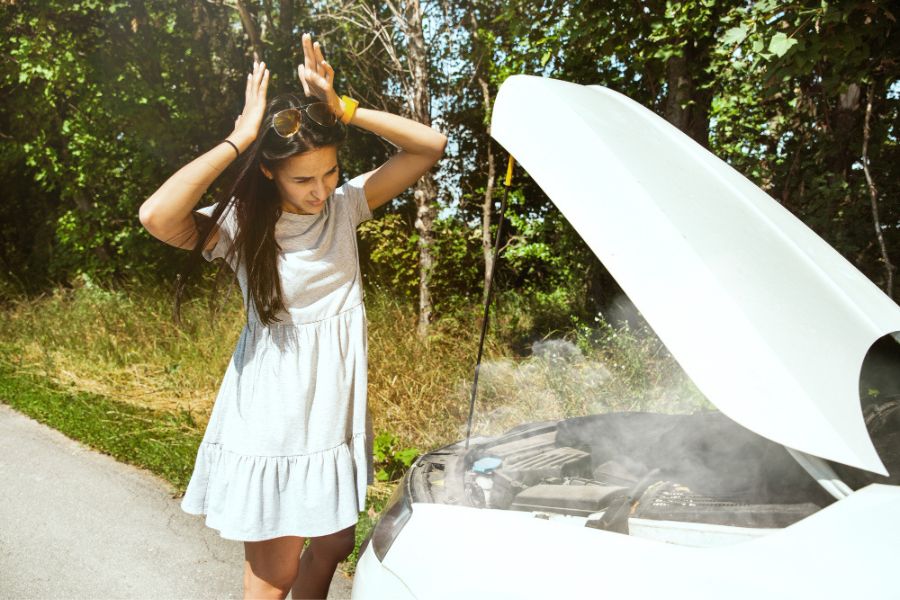Quick Navigation
Are you having trouble starting your car lately? You are probably having car starters issues.
A car starter consists of an electric motor that will crank your engine after you switch the key to its position.

It is powered by a battery that gets to your engine to make it run after transmitting power.
Starters will experience wear and tear over time, giving you some signs that will help you diagnose that it starts to fail.
This article will explain the symptoms of bad starters and their solutions to help determine whether it’s time to repair or replace it.
Car Starter Issues and Symptoms
Here are the symptoms and issues that will help you determine that you have a bad starter.
1. The Engine Won’t Start
It is the usual indicator that your starter has issues when it does not start after you turn the key or press start.
You might hear clicking sounds after you turn the key, or you hear nothing at all. It might be due to the starter relay, the motor being burned out, or an electrical problem.
2. Unusual Noises
After you insert the key or press start, you’ll hear unusual sounds such as clicking, whirring, and grinding.
Any sounds you hear indicate the impending death of your starter. If your starter components are worn out, it produces these sounds.
Please pay attention to these sounds, as they can damage your engine flywheel when left unattended.
3. You Spot Smoke Coming from Under the Hood
A starter is prone to overheating as it is a mechanical system powered by electricity. If you start your car, it does not start; repeating it can cause overheating.
It can cause the system to overheat when there is a continuous power supply. Once it overheats, you can smell or see smoke beneath your engine.
4. The Car Starts Having Intermittent Issues
If you tried starting your car, but the engine did not ignite immediately, and it works on the second try, it is a starter relay issue.
If this intermittent starting happens, it might be due to a damaged relay that sends a total electric current or nothing.
5. Battery Issues
If your car lights on your dashboard and the headlights are working fine, but the engine didn’t start, your battery might have issues.
It needs a lot of power to crank your engine, and your battery might be weak to sustain it.
6. The Starter Is Still on After Starting
Once the engine starts, the starting circuit should close, and the releasing key will let go of the start button.
The starter relay must be stuck when there is continuous grinding from under your car after it is up and running.
7. Starter System Soaked with Oil
The starter is located on the bottom of your engine; this portion usually experiences oil leaks and is a very hot zone.
It’s not surprising if oil soaks your starter system. Please pay attention when your starter system is covered with oil, as it can damage its function and shorten its lifespan.
Starter Issues Troubleshooting
You should look into three categories in troubleshooting: starter and battery, ignition, and fuel delivery.
1. Check Your Car Starter and Battery
Listen to your vehicle when you start; to determine if you have a weak or dead battery.
When you start your car and hear a sound, your battery is weak and cannot sustain enough power. If you don’t hear anything, it means your battery is dead.
Check the battery terminals; there are two positive and negative terminals. It should have metal-on-metal to transmit sufficient electricity.
Ensure that both are connected tightly to avoid pulling off the battery and are not covered with debris or oxidization.
Test the battery; after checking your battery cables, test it using a voltmeter to test its voltage.
Turn on the voltmeter and touch each positive or negative terminal.
It should read 12.4 to 12.7 volts when the battery is fully charged. If the battery is dead, try jumping the start, and if it does not hold a charge, replace it immediately.

Try to jump-start the vehicle; if the battery cables are secure, you can use another car to jump-start the engine.
Connect two batteries and ensure that cables are connected properly to the positive and negative terminals to avoid severe damage to your vehicle
Test the starter solenoid; if the jump-start did not work, the solenoid might be the problem.
Use a test light, touch the solenoid’s bottom terminal, and ground the negative cable in the vehicle’s body.
Look for a friend to help you start the car and see if the solenoid engages. If it does not engage, it is damaged, so replace it immediately.
2. Make Sure the Engine Is Getting Fuel
Add more fuel; when your vehicle is out of gas, make sure to have sufficient power to start your engine.
Signs of jerking; please pay attention to signs of jerking when you drive before it dies. It’s a common sign that a vehicle’s fuel system is jerky or has inconsistent power.
Check if the vehicle will start again; after a while or let it sit for 20 minutes. If it starts after a while, it is due to the clogged fuel filter.
Replace the fuel filter; If your car does not have enough fuel to power up, replace your fuel filter. Remove it on the bracket and install a new one to have a consistent fuel flow on the engine.
Check the fuel pump; to identify if it receives the electric current correctly. If it’s not working well, replace it. You can read your car’s manual guide on how to replace it.
3. Test Your Car Ignition System
Check the spark plugs; if there’s a sign of damage. Remove the spark plugs using a spark plug socket to inspect them.
The color will indicate if it’s damaged; grey or tan is in good condition, while black or burnt plugs indicate too much fuel going on the engine.
Replace spark plugs; if the spark plugs look worn out, replace them immediately so your engine will run properly.
Check the plug wires; check them if they are securely fastened in the spark plug and the ignition coil.
If there are cracks in the plug wires, replace them immediately. You can use an Ohm meter to have a spark plug-resistant test.
Test the ignition coils; to see if they function correctly. Test it by removing the spark plug and connecting it again to its plug wire.
If the coil operates well, it will have a blue spark from the plug; test each coil in your engine correctly.
4. Get Professional Help
Calling a professional mechanic or technician is the best solution if you are not confident about troubleshooting.
An experienced mechanic will help you diagnose your car starter problems properly.
Conclusion
Having issues with starting your car is troublesome and will delay your schedule.
Before it happens, be aware of the failing symptoms of your starter to avoid troubles while you start driving.
Check your car’s battery and starter system, fuel delivery, and ignition regularly to prevent starter problems in the future.
Replace the parts that need to be replaced to ensure your engine will work properly to have a safe driving experience.
If problems still occur, calling an experienced mechanic is a better choice. It will help you solve your problems without worrying too much and avoid severe damage in the future.

With comprehensive experience in writing exceptional quality articles and blogs about cars and related stuff, Daniel is one of the finest bloggers and a hardcore car lover we have. He is an ASE certified technician with an across-the-board experience of 10 years in the industry. He could not help tinkering with anything he got his hands on from a young age, which led to his remarkable career in the automotive repair industry.
When he is not under any hood, you can find him on the water or in the woods to pursue his passion for hunting and fishing. He has been writing for multiple sectors and is a regular contributor to several publications.
He currently owns a Nissan 300ZX TT and a Pearl Yellow but plans to upgrade it to 550 HP. His favorites include the Koenigsegg CCX and Lamborghini Diablo 6.0 VT, but for him, the Ferrari 360 Spider is one of the sexiest cars that exists to date.
Being an avid world traveler, he has spent most of his time analyzing the automotive markets, latest technology, and local favorites to enhance his knowledge base. He is currently living in North Caroline, where it’s all about food and coffee and, of course, cars.







